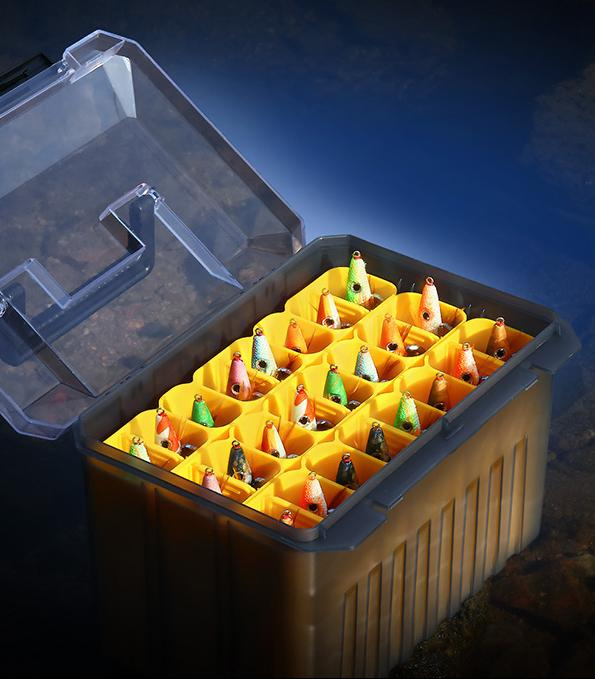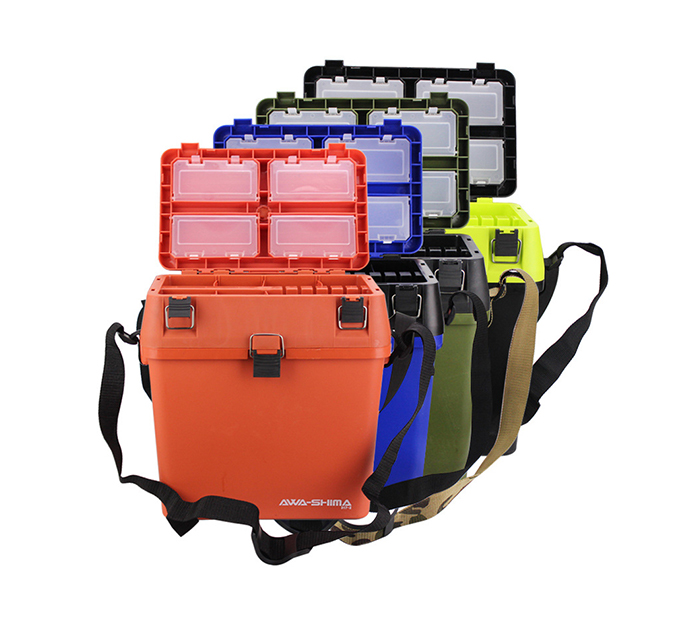Stocking your tackle box with the perfect mix of fishing lures isn’t just about having lots of options—it’s about being ready for anything. Whether you’re after bass in muddy shallow spots or chasing tuna far out at sea, picking the right lure can make or break your day on the water. It’s the difference between hauling in a big catch or heading home with nothing to show for it. If you’re really looking to step up your fishing game, think about how you keep and carry your gear too. Laike has been making fishing equipment for over a decade. With a huge range of more than 500 products shipped more than 20 countries and regions, they’ve got everything from lures to rods and lines.

Are You Equipped with the Right Hard Lures for Versatile Conditions?
Hard lures are a must-have in any fisherman’s setup. Their tough build lets you control how they move, how deep they go, and even the kind of shakes they send out through the water. That’s super important when you’re fishing in all sorts of places.
Crankbaits for Depth Control and Structure Targeting
Crankbaits are awesome when you need to check out different water depths fast. The little lip on them decides how far down they dive. So, they’re great for finding fish hiding near stuff like underwater rocks or fallen trees. Go for a crankbait with a wide wobble in cloudy water to make more ripples. But in clear water, pick one with a smaller, tighter wobble for a sneakier approach.
Pair them with a trigger stick, which has a longer grip for casting with both hands. This setup helps you throw your line way out to far-off spots without losing your aim. It’s a real game-changer on big lakes.
Minnow Lures for Realistic Swimming Action
Minnow lures look so much like real baitfish it’s almost creepy. Their skinny shape and quick little wiggle drive hungry fish like bass, trout, or pike totally wild. Try pulling them in at different speeds. Or give them a quick tug now and then to make them look like a scared fish darting away.
A shorter rod works best for regular casting in smaller rivers or streams. It’s especially handy when using minnows to go after fish like red tail or blue tip in tight spots where the water doesn’t spread out much.
Topwater Baits for Surface Strikes
There’s nothing like the thrill of seeing a fish smash a lure right on the surface. Frogs, poppers, and walking baits each have their own job based on how thick the weeds are or how the fish are acting. The best times to use them are early in the morning or right around sunset. That’s when predators hide near lily pads or grassy edges, just waiting to pounce.
Have You Included Metal Jig Lures for Deep Water Success?
If you don’t have metal jigs in your tackle box, you’re skipping out on one of the handiest tools for deeper waters. Regular baits often take too long to sink down there, but jigs get the job done quick.
Vertical Jigging in Saltwater and Freshwater Environments
Metal jigs are fantastic for straight-up-and-down fishing. Just drop them into deep spots or near underwater structures way out in the ocean. Then, flick your rod tip a bit to get fish to bite out of pure instinct. They work just as well in freshwater lakes as they do in saltwater. So, whether you’re after lake trout at 60 feet down or amberjack near coastal reefs, these jigs have got you covered.
Long Casting Capabilities in Windy Conditions
Since metal jigs are heavy and compact, they slice right through strong winds. That makes them a top choice for fishing from the shore on blustery days. Match them with a medium-stiff rod and a spinning reel to throw your line super far without messing up your control.
Flash and Vibration to Attract Predatory Fish
The shiny sides of metal jigs catch the light as they sink, looking like a struggling baitfish. Add in their wild, jerky movements, and they’re deadly for fast-swimming fish that hunt by sight. It’s like ringing a dinner bell for them down there.
Are Soft Plastic Lures Part of Your Tactical Arsenal?
Soft plastic lures are incredibly handy because they feel and move so lifelike. They’re a go-to when you need to be sneaky or when the fish are getting spooked by too many anglers around.
Worms and Grubs for Finesse Presentations
When the weather turns cold or the water’s super clear, you’ve got to be subtle. That’s when worms rigged Texas-style or on a drop shot can trick even the pickiest fish into biting. Grubs are great too, especially on jig heads near rocky bottoms. They look just like tiny crabs or other critters fish love to snack on.
For the best results, pair a lead hook rig with a soft bait that has a big, dramatic wiggle. This setup looks like prey trying to escape. Plus, it’s easy to keep your depth steady with light jig heads under 10 grams.
Swimbaits Mimicking Natural Prey Movement
Swimbaits are amazing at any depth because of the way their tails flap around. They work in both freshwater and saltwater, no matter how deep or shallow the spot is. Pick colors like green pumpkin or shad to match whatever the local fish are used to eating. It makes a huge difference.
These baits go well with fish-shaped lead hooks hidden inside the soft body. That keeps them from snagging on weeds while still working great around underwater plants or junk.
Creature Baits for Heavy Cover Fishing
Creature baits are built for busting through thick weeds or brush. Their weird little arms and legs make a ruckus in the water, grabbing attention even when it’s hard to see. Rig them weedless on sturdy hooks with bullet weights when you’re flipping into heavy mats or downed logs.
Do You Rely on Spoon Baits for Flash and Flutter?
Spoons have been around forever, and there’s a good reason they’re still popular—they flat-out work. They’re awesome at different depths and should always have a spot in your tackle box.
Classic Spoon Action to Trigger Aggressive Hits
The way spoons wobble looks just like a hurt baitfish struggling along. Predators can’t help but go for it. Whether you’re dragging them behind a boat or casting from the shore, spoons bring steady results all year round.
Versatility Across Species and Water Columns
From high mountain trout lakes to salty coastal flats full of mackerel, spoons adjust easily. Just change how fast you reel them in or switch to a heavier or lighter one. They’re perfect when you’re packing light but still want to catch a wide range of fish.
Durable Construction Ideal for Repeated Use
Spoons are usually made from tough metals that don’t rust easily. They hold up fine even in salty, brackish water where other lures might fall apart after a few trips. That kind of staying power is hard to beat.
Are You Using Fly Fishing Lures in the Right Scenarios?
Fly fishing isn’t just for quiet mountain creeks anymore. It’s grown into a flexible way to fish for all kinds of species, from tiny panfish in ponds to redfish on coastal flats. You just gotta pick the right fly for the job.
Dry Flies for Surface Feeding Fish
Dry flies sit lightly on top of the water, looking like grown-up bugs during a hatch. They’re best on calm days when fish are popping up near the shore or in slow-moving spots, staring up for their next meal instead of down.
Nymphs and Emergers for Subsurface Presentation
When fish stop hitting the surface but are still eating below, nymphs are your best bet. The heavier ones sink fast to deeper areas. Meanwhile, lighter emergers copy bugs changing from babies to adults halfway down. That’s a snack many new fly fishermen don’t even think about, but fish sure notice.
Streamers Imitating Larger Aquatic Prey
Streamers look like leeches, crayfish, or young baitfish depending on their color and how you pull them through the water. Reel them in quick near steep drop-offs where tough fish wait to ambush anything moving like easy prey, such as sculpins or shiners.
Is Your Storage System Optimized with Laike’s Tackle Boxes?
Keeping things tidy isn’t just about neatness—it’s about being fast and ready when the fish are biting, or when you’re switching spots in the middle of a hot streak during a competition. A messy box can cost you precious time.
24 Grids Plastic Fishing Tackle Box
The 24 Grids Plastic Fishing Tackle Box comes with separate slots to keep crankbaits away from swimbaits. That means no tangled hooks, which is a lifesaver when every second counts before your next cast. Made from ABS+PP, it’s tough enough to handle bumpy rides or rough days out on the boat.

4 Colors Portable Multi Function Tackle Box
For folks who like to switch up their gear depending on the trip—say, saltwater one day and freshwater the next—the 4 Colors Portable Multi function Tackle Box has color-coded sections to keep

Durable ABS+PP Material Ensuring Longevity in Harsh Environments
Both of these tackle boxes are built from a strong plastic mix that doesn’t crack under sunlight, get ruined by water, or break when dropped. That’s exactly what you need whether you’re stashing them under a boat deck or hauling them on your back to some far-off mountain lake. They’re made for outdoor adventures, plain and simple.
FAQ
Q1: What kind of lure should I use in deep saltwater?
A: Metal jigs are a top pick. They sink fast to deep spots and have a bright flash that grabs attention down there, plus they’re great for straight-up-and-down fishing.
Q2: What soft plastic setup is good for weedy areas?
A: Creature baits rigged weedless with bullet weights are perfect. They’re tough enough to punch through thick stuff like lily pads or underwater branches.
Q3: Can fly fishing work beyond just mountain streams?
A: For sure, streamers do great in bigger rivers or even saltwater flats. Just make sure the size and color match whatever the local fish are eating.




